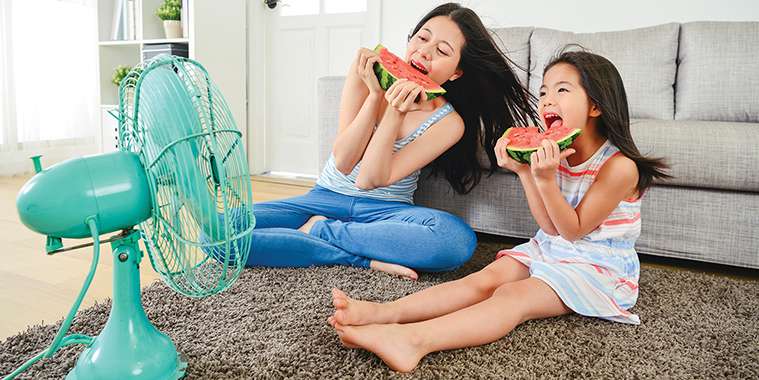It seems like heat waves during our summers are now a thing. No worries, though, you can just retreat to your air conditioned home to cool off. If you have air conditioning, that is . . .
If for whatever reason you don’t have air conditioning in your home, condo or apartment, there are options to help you out. Homeowners across Canada are finding ways to cool their living spaces without A/C using guidance from heating, ventilation, and air conditioning (HVAC) experts.
When you can’t control the temperature inside your home, there are certain tactics to help you stay cool. This includes creating a cross-breeze with strategically placed floor fans; exhausting hot air from your home using bathroom fans; and pushing cool air down by turning your ceiling fan counterclockwise. And if you have a small budget for some minor renovations, or you can justify buying a few useful products, you’ll keep comfortable despite the rising mercury.
Don’t let the summer sun melt the days away, be prepared for the next heatwave. Learn how to keep your house cool without air conditioning by employing the following tips, tricks and cooling techniques recommended by the pros.
Keeping cool during the day
During the day, the goal is to stop the heat from climbing while maintaining the room temperature. This means finding ways to allow hot air to escape, while filtering out heat sources in your home. For example, shuttering blinds, hanging blackout curtains, and applying a heat-reflecting film to your windows keeps you cooler by blocking out the sun’s heat — turning on the vent fan above your oven or in your bathrooms can also help draw some of the warm air out of your house.
The key to staying cool without air conditioning is to keep the air moving. Moving air is drier (less humid), so it feels cooler even though you haven’t changed the temperature. This is best done with fans:
• Place floor fans on the opposite ends of a room — one blowing in and the other blowing out — to create a cross-breeze and a constant flow of air entering and exiting the space.
• Turn your ceiling fan counterclockwise to offset hot air as it rises — rather than sucking up and circulating the heat, the fan pushes the air back down, removing the humidity and making it feel cooler in the process.
• Blow the air from your basement — which is cooler — into the main living space by using floor fans to move the air from one end of the room and up to the next level.
Of course, fans aren’t your only option to regulate the temperature of your home. Try closing bedroom doors to minimize the amount of space you need to cool, and don’t feel guilty about putting off activities on the to-do list that generate heat — for example, doing laundry, vacuuming the floor, and cleaning dishes.
Keeping cool at night
As the sun goes down and the balmy, summer night sets in, the outside temperature will eventually dip below the inside temperature of your home. This is your opportunity to take advantage of what’s considered “free cooling.” Let the fresh air in by opening windows, spreading curtains, and widening blinds — position floor fans to draw the outside air in and circulate it through your house.
Open bedroom doors and maximize the air flow down hallways and throughout each room — once again, create cross-breezes wherever possible to keep the cool air moving. And if that doesn’t do the trick, why not make your own air conditioner? Fill a large bowl with ice cubes and place it behind a table fan; set the fan to static and drape a towel over the back covering the bowl. Admittedly, the ice melts quickly, but before it does, you’re graced with a delightfully cold breeze.
When it comes to cooking dinner, a barbeque is your best friend — nothing cranks up the heat in your home like using the oven or turning on the burners. Plus, everything tastes better off the BBQ. If you don’t own a barbeque, consider meals with little prep work and short cooking times, or treat yourself and order takeout from your favourite restaurant occasionally.
Surprisingly, your television, computer, laptop, and other electronic devices generate a significant amount of heat, which is only compounded by the sweltering sun. As for the fridge, the longer you keep the door open, the harder the compressor works to maintain the cool temperature — the harder the compressor works, the hotter it gets inside your home.
5 cooling investments
Despite keeping your home cool, air conditioners heat up your utilities bill, and the warmer it gets outside, the more expensive it is to stay comfortable. Whereas, a few key renovations end up cheaper in the long run. If you can justify the upfront expenditure, consider the following five investments to keep your house cool without A/C:
1. Install a ridge vent on your roof to allow hot air to escape from your attic, but for installation, it’s best to hire a professional to prevent moisture damage to your roof and insulation.
2. Purchase a dehumidifier to keep the humidity out of the air. There are several models available, so do your research to find what’s best for your home.
3. Replace all incandescent light bulbs with LED alternatives. Incandescent bulbs use more electricity (generate more heat), while LED lights are more than 75% energy efficient.
4. Buy a digital indoor/outdoor weather station to track the weather and monitor the temperature to pinpoint the ideal times to exploit free cooling.
5. Employ passive cooling techniques outside of your home by strategically planting bushes, gardens, and even trees to help prevent the sun from heating the foundation of your home.
— Realtor.ca



